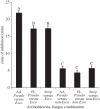Specificity in the symbiotic association between fungus-growing ants and protective Pseudonocardia bacteria
- PMID: 21106596
- PMCID: PMC3097832
- DOI: 10.1098/rspb.2010.2118
Specificity in the symbiotic association between fungus-growing ants and protective Pseudonocardia bacteria
Abstract
Fungus-growing ants (tribe Attini) engage in a mutualism with a fungus that serves as the ants' primary food source, but successful fungus cultivation is threatened by microfungal parasites (genus Escovopsis). Actinobacteria (genus Pseudonocardia) associate with most of the phylogenetic diversity of fungus-growing ants; are typically maintained on the cuticle of workers; and infection experiments, bioassay challenges and chemical analyses support a role of Pseudonocardia in defence against Escovopsis through antibiotic production. Here we generate a two-gene phylogeny for Pseudonocardia associated with 124 fungus-growing ant colonies, evaluate patterns of ant-Pseudonocardia specificity and test Pseudonocardia antibiotic activity towards Escovopsis. We show that Pseudonocardia associated with fungus-growing ants are not monophyletic: the ants have acquired free-living strains over the evolutionary history of the association. Nevertheless, our analysis reveals a significant pattern of specificity between clades of Pseudonocardia and groups of related fungus-growing ants. Furthermore, antibiotic assays suggest that despite Escovopsis being generally susceptible to inhibition by diverse Actinobacteria, the ant-derived Pseudonocardia inhibit Escovopsis more strongly than they inhibit other fungi, and are better at inhibiting this pathogen than most environmental Pseudonocardia strains tested. Our findings support a model that many fungus-growing ants maintain specialized Pseudonocardia symbionts that help with garden defence.
Figures


References
-
- Margulis L., Fester R. 1991. Symbiosis as a source of evolutionary innovation, p 454 Cambridge, UK: MIT Press - PubMed
-
- Moran N. A. 2007. Symbiosis as an adaptive process and source of phenotypic complexity. Proc. Natl Acad. Sci. USA 104, 8627–863310.1073/pnas.0611659104 (doi:10.1073/pnas.0611659104) - DOI - DOI - PMC - PubMed
-
- Geurts R., Fedorova E., Bisseling T. 2005. Nod factor signaling genes and their function in the early stages of Rhizobium infection. Curr. Opin. Plant Biol. 8, 346–35210.1016/j.pbi.2005.05.013 (doi:10.1016/j.pbi.2005.05.013) - DOI - DOI - PubMed
-
- Fraune S., Bosch T. C. G. 2007. Long-term maintenance of species-specific bacterial microbiota in the basal metazoan Hydra. Proc. Natl Acad. Sci. USA 104, 13 146–13 15110.1073/pnas.0703375104 (doi:10.1073/pnas.0703375104) - DOI - DOI - PMC - PubMed
-
- Nyholm S. V., Stewart J. J., Ruby E. G., McFall-Ngai M. J. 2009. Recognition between symbiotic Vibrio fischeri and the hemocytes of Euprymna scolopes. Environ. Microbiol. 11, 483–49310.1111/j.1462-2920.2008.01788.x (doi:10.1111/j.1462-2920.2008.01788.x) - DOI - DOI - PMC - PubMed
Publication types
MeSH terms
Substances
LinkOut - more resources
Full Text Sources
Other Literature Sources
Molecular Biology Databases
